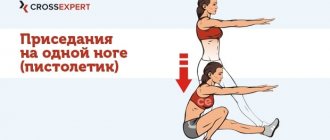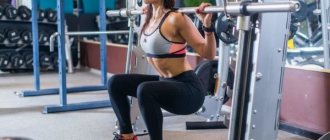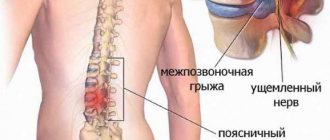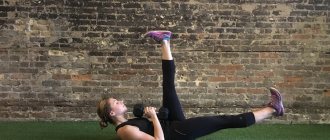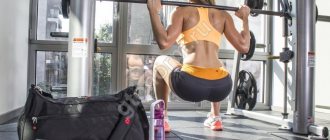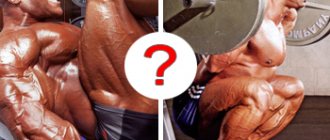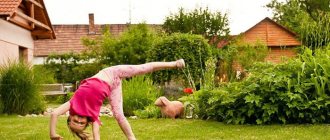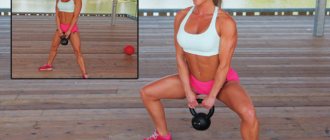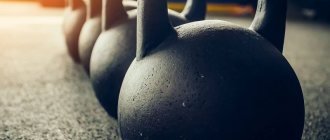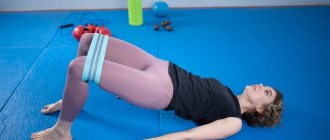Single-leg squats are an effective leg muscle development exercise that also strengthens the abs, develops balance, and improves agility and strength. Surely you remember these squats from school - all boys pass the pistol standard from about 8th grade. But for adults, it is much more difficult to master the exercise - both the body weight is greater and the muscles are not as prepared.
However, this exercise is considered extremely productive, which is why many athletes are interested in how to learn to pistol squat on one leg at home or in the gym, with the help of auxiliary equipment.
What is the exercise
Its name speaks for itself - it is a squat on one limb, while the other is held suspended in front of you. It can be performed in any room or even during street training. It wonderfully develops the quadriceps femoris muscle, as well as the gluteus maximus. Due to the shifting of the center of gravity in the process, it trains the sense of coordination and balance. If you squat without additional weight, you place virtually no stress on your spine. By the way, in order to keep your non-working leg suspended, you will need strong abs, which means that at the same time you are working on the treasured abs on your stomach along with your hips.
Do you want to know how to properly squat on one leg with a pistol squat? If so, read on.
Execution technique
To get started, check out our tips that will help you master the technique faster:
- Do a good warm-up, thoroughly warm up your muscles, ligaments and joints. To prepare for this particular exercise, perform classic squats, running in place, jumping;
- The squat is performed smoothly, without jerking or acceleration on the descent or ascent;
- If you can’t maintain your balance at first, stand at a support. But remember, it only helps maintain balance, and is not a lever or tool to make the task easier. If you're still tempted to lean on a handrail or wall while lifting, try doing one-legged back squats;
- You will need to constantly monitor your free limb to ensure it does not touch the floor. To make this part of the exercise easier, try squatting from an elevated position, such as a gymnastics bench.
- Stand up straight, transfer your body weight to your working leg, lift the other one off the floor, slightly bending it at the knee;
- Tighten your abs, stretch your arms forward and make sure you have your balance;
- Tilt your pelvis slightly back, and the upper part of your body, on the contrary, forward, and, while inhaling, begin to slowly lower;
- Gradually straighten the free leg, at the lowest point it should be in a position parallel to the floor, without touching it;
- As you exhale, begin to rise, pressing as much as possible on your heel - slowly straighten your knee, pushing your body up;
- Do the required number of repetitions and change legs.
Single leg squats by difficulty level[edit | edit code]
Related article:
Bulgarian squats with lunges without weights
Posted by BJ Gaddour
In the first case, each leg bears only half the body weight, the support base is wider and there are two points of contact with the floor. In the second case, the supporting leg bears the weight of the entire body, the support base is smaller and there is only one point of contact with the floor. A bridge needs to be built across this chasm, the role of which is played by progressions, which we will consider below.
Single leg squats
useful in that they work all the muscles of the lower half of the body in all three planes of movement. As you move up and down, you have to overcome lateral and rotational forces. The single leg stand requires activation of all the muscles that stabilize the knees and spine. If you think about it, you can understand that the one-leg stand is, in fact, a vertical plank pose on one leg.
Throughout the day, we have to constantly shift our body weight to one leg. This occurs, in particular, while walking or running. This is why it is so important to include squats not only on two legs, but also on one leg, in your training programs.
Everyone has a disparity in strength and flexibility between sides of the body. And if you limit yourself to squats on two legs, then the existing disparity will only worsen, which entails an increased risk of injury, not to mention the fact that this is bad from a functional point of view. The better you become at squatting on one leg, the better you will be at squatting on two legs. As a general rule, to correct imbalances between the sides of the body, for every set of squats performed on the stronger leg, you should perform 2-3 sets of squats on the weaker leg.
Single Leg Squat Progression
| Level 1 Complete zero | Level 2 Elementary | Level 3 Intermediate | Level 4 Advanced | Level 5 Superhero |
| Single leg squat against a wall | Climbing onto the step platform | Squat with diagonal legs | Lunge | One leg squat |
Single leg squat against a wall[edit | edit code]
Single-leg wall squat
The one-leg wall squat is an exercise that anyone can do, especially if you keep your hip above your knee as needed. This is a safe, reliable, and low-skill way to lower yourself into the bottom position of a single-leg squat. Due to the vertical position of the body, increased stress is placed on the quadriceps muscles of the thighs, which helps strengthen all the muscles around the knees. This is especially important for people who have had knee problems or injuries, since holding a squat is easier than repeating full-range squats. Although this exercise belongs to the lowest level of difficulty, it can also be performed by trained athletes for the purpose of warming up, active recovery between workouts, or developing endurance. In addition, if you squat deeply enough so that your hips drop below your knees, this exercise can be difficult even for the most fit.
Technique for performing a one-legged wall squat
Initial position
- Stand with your back to the wall, legs hip-width apart, and arms extended in front of you. The heels should be 0.5 meters from the wall.
- Maintain a three-point position with your feet.
- Squat down so that your knees and hips are at a 90-degree angle and your pelvis, upper back and head are touching the wall.
Perfect execution
- Slowly shift your body weight onto your supporting leg and lift your other leg in front of you.
- Keep your torso as straight as possible and hold this pose for a while.
- If you get tired ahead of time, simply reduce the depth of the squat as needed.
- After 60 seconds, repeat the exercise for the other supporting leg.
Target
Before moving to the next level, you should be able to hold the single-leg wall squat position several times for 60 seconds, lowering your hip below your knee.
Regression (decrease) of exercise difficulty
- Easier option
: Change your supporting leg every few seconds.
- An even easier option
: Reduce your range of motion, lowering yourself so that your hip remains above your knee.
- Easiest option
: Press the toe of your non-working leg into the floor. This will provide the additional support needed
Progression (increase) of exercise difficulty
- More challenging
: Increase your range of motion by lowering your hip below your knee.
- Even more difficult option
: Use arm progressions that gradually make the exercise more difficult. First, wrap your arms crosswise around your shoulders (or keep your arms close to your chest in a prayer position). Then fold your hands at the back of your head (prisoner pose). Finally, lift them above your head.
- Hardest Variation
: When the time for holding the one-legged wall squat position is up, lower your leg and hold the two-legged wall squat position. This will help strengthen your thigh muscles faster, accelerate the growth of muscle tissue and develop endurance.
Climbing onto the step platform[edit | edit code]
Climbing onto a step platform
Climbing onto a step platform should be one of the main exercises of any training program for the lower half of the body, because we have to walk on stairs and climb curbs every day for many years of our lives. The step up is essentially the reverse of a single-leg squat, only much easier: you start from the bottom of a single-leg squat with your back leg supporting you. It's also one of the best exercises for strengthening your glutes and An excellent diagnostic tool for assessing strength, stability and stability in the single leg stand. If you can't step up on a step platform at a slow, controlled pace with a full range of motion and without any pain, then you shouldn't even think about lunges, single-leg squats, or running or jumping for that matter. .
Technique for climbing onto a step platform
Initial position
- Place one foot on the step platform. The body weight is transferred to the center of the foot.
- The foot rests on three points.
- The height of the step platform should be such that the knee of the raised leg is higher than the hip.
Perfect execution
- First, move your pelvis back, and then rise onto the step-plate form, tensing the gluteal muscles of the supporting leg in the upper position.
- Hold this position for a while, resisting the forces trying to tilt and rotate your body.
- Push your pelvis back again and slowly lower your back leg to the floor. The process of returning to the Starting position
should take you at least 3 seconds.
Target
Before moving to the next level, you should be able to perform several sets of 10 repetitions dropping your hip below your knee.
Regression (decrease) of exercise difficulty
- Easier option
: Use a lower step platform.
- An even easier option
: Help yourself with your hands by holding on to a wall or other support.
- Easiest option
: Perform a stand on the step platform, keeping your non-working leg suspended (as low as possible, given the height of the step platform).
Progression (increase) of exercise difficulty
- More difficult option
: Use
Progression (increasing) the difficulty of the
arm exercise, gradually making the exercise more difficult. First, wrap your arms crosswise around your shoulders (or keep your arms close to your chest in a prayer position). Then fold your hands at the back of your head (prisoner pose). Finally, lift them above your head.
- Even more challenging
: Perform jumping jacks on a step platform, ending each rep with a one-leg jump and landing softly in
the Starting position
. You can perform all repetitions on one leg and then switch legs, or switch legs while jumping.
- The most difficult option
: Use a step platform of such a height that the surface of the thigh of the working leg, raised on it in the starting position, rests on the calf. The higher the step platform, the further you need to move your pelvis in order to correctly perform the movement.
Squat with diagonal legs[edit | edit code]
Squatting with diagonal legs
In sports, the ideally correct stance, when both legs are at the same level, is rarely used. More often than not, one foot ends up in front of the other. This is why it is so important to perform different variations of squats with your legs in a diagonal position. These variations serve as a transition to single-leg squats, and they also put less strain on your back than regular squats.
Important note. You need to understand the difference between the diagonal position of the legs and the spread leg position. The diagonal position of the legs is said to be when the toe of the rear leg is at the same level as the heel of the front leg. This position of the legs forces the quadriceps and calf muscles to work more intensely. A step-up is when your back leg is pulled far back and resting on your toes, as if you were performing a stationary lunge. In this position, the back and lateral muscle groups of the thighs work more intensely. A step-up is essentially a diagonal position of the legs, only with a larger distance between them. It is better to start with a diagonal position of the legs, and then increase it to a spread.
Technique for performing squats with diagonal legs
Initial position
- The foot of the front leg rests on three points.
- Spread your legs hip-width apart; the toe of the hind leg is at the level of the heel of the front leg.
- Shift your body weight to your front leg so that your back leg plays only a supporting role, providing stability and providing some assistance to your front leg.
Perfect execution
- First, push your pelvis back and lower yourself into a squat as low as you can until the back of your front leg touches your calf.
- Hold this position for a while, and then stand up, fully extending your hip joints and squeezing your gluteal muscles in the upper position.
- Perform all repetitions on one supporting leg, and then switch legs. Always start the exercise using your weaker leg as a support leg.
Target
Before moving to the next level, you should be able to perform several sets of 10 repetitions on each leg, lowering your hips below your knees.
Regression (decrease) of exercise difficulty
- Easier option
: Squat only to such a depth that the folds of the legs at the hip joints are just below the folds of the legs at the knees.
- Even easier option
: Squat as far as you can without pain.
- The easiest option
: Perform squats while holding onto support with your hands (handles of hanging straps, handrails, a pole, etc.). This will allow you to perform the necessary movements with full amplitude and without pain.
Progression (increase) of exercise difficulty
- More difficult option
: Perform split squats (scissor exercise) with your back leg further back. In the bottom position, the knees and hips should be bent at a 90-degree angle so that the knee of the back leg almost touches the floor. Fully extending your leg at the hip joint, keep your body vertical, tighten the gluteal muscles of the back leg and the muscular corset
- Even more challenging
: Perform a split squat by lifting your back leg onto a knee-high step platform. Hanging straps can also be used. This will help loosen the hip flexors in the back leg.
- The hardest option
: Perform split squats with both legs on step platforms.
Lunge[edit | edit code]
Lunge
After squats, lunges are perhaps the most popular non-weight bearing exercise for the lower half of the body. But most people start these exercises without proper preparation. Lunges are advanced exercises that require dynamic stability of the body as they move the legs and change the base of support. Do more lunges and you'll strengthen your legs, protect your knees from injury, and prepare your body for the demands of explosive movements like running and jumping. The greater the distance between the legs, the higher the load on the pelvic muscles and the posterior thigh muscles. The smaller the distance between the legs, the greater the load on the quadriceps and calf muscles. Keep in mind that it is easier to switch legs after completing all the reps rather than every other time.
Lunge technique
Initial position
- Spread your legs hip-width apart.
- The feet rest on the floor at three points.
- The body weight is transferred to the center of the feet, toes pointing forward.
Perfect execution
- Step one foot back and lower into the bottom lunge position.
- For a while, fix the lower position in which the bend angle of the front leg at the knee is 90 degrees, and the knee of the back leg almost touches the floor. The thigh of the back leg should be in the same plane as the shoulder joint on the same side of the body.
- Bringing your hips forward, return to the starting position
.
Target
Before moving to the next level, you should be able to perform several sets of 10 repetitions for each leg.
Regression (decrease) of exercise difficulty
- Easier Option
: Lunge your leg just enough so that it doesn't hurt.
- An even easier option
: Reduce the step back even more so that the pose is more stable and the back leg helps the front more.
- The easiest option
: Do lunges while holding onto a support. This will allow you to perform the necessary movements with full amplitude and without pain.
Progression (increase) of exercise difficulty
- More challenging
: Perform a reverse lunge with your front foot on a low step platform to increase the stretch.
- Even more challenging
: Perform lunges with a sliding disc or paper plate under your back foot. Slide your back foot back while lowering to the bottom position, and then return to the
Starting position
. During the entire exercise, the back leg does not leave the floor.
- Hardest Option
: Perform lunges with your rear foot elevated. Step back so that the knee and top of the foot of your back leg are on the floor (a). Continue to extend your leg back until only your knee touches the floor, your shin is raised, and your knee is bent at a 90-degree angle (b).
Single leg squat[edit | edit code]
One-leg squat
It is important to understand the difference between a regular one-leg squat and a pistol squat. In the first case, we are talking about any one-leg squat, even a shallow one, where the crease of the leg at the hip joint remains above the crease at the knee. What the non-working leg does at this time does not matter, although most often it is bent at a right angle, the foot is located behind the body. The Pistol Squat is a single-leg squat that is as deep as possible, with the hamstring resting on the calf with the non-working leg extended forward (this requires significant flexibility in the hamstrings). In the lower position, the body resembles the shape of a pistol, hence the name of the exercise. Although your ultimate goal
To learn how to perform these squats perfectly, keep in mind that achieving them requires a lot of work, especially for large and tall people. To do this you need to have extremely mobile hip, knee and ankle joints. That's why most people limit themselves to performing self-assisted pistol squats or low-step pistol squats. Ultimately, regular single-leg squats provide 80 percent of the benefits that pistol squats would provide, so don't worry if you feel that you are light years away from being able to do the latter.
Single leg squat technique
Initial position
- Stand on one leg and extend the other in front of you.
- The foot rests on three points. The body weight is transferred to the center of the foot.
- For balance, hold a light weight in your arms extended in front of your chest.
Perfect execution
- Move your pelvis back as far as possible (as if you were closing a door with it). Bend your knee and slowly lower yourself into a squat.
- Lower yourself as far as you can without rounding your back. If you can't get down to the lowest position (where your hamstring rests on your calf), at least try to get the crease of your hip below the crease of your knee.
- Hold the lower position for a short time, and then, straightening your supporting leg, move your pelvis forward and return to the starting position.
Target
When you can perform multiple sets of 10 reps on each leg, dropping your hip below your knee, you'll have every reason to call yourself a master of the single-leg squat!
Regression (decrease) of exercise difficulty
- Easier option
: Perform squats on a step platform. The non-working leg should be fully extended forward, as when performing pistol squats. Using a step platform allows you to increase the load on the thigh muscles and reduce the load on the knees. Gradually reduce the height of the step platform.
- An even easier option
: Perform single-leg squats on a step platform. The working leg stands on the step platform, and the non-working leg is lowered to the floor. Gradually increase the height of the step platform.
- The easiest option
: Perform squats with your hands holding support (handles of hanging straps, handrail, etc.). This will allow you to perform the necessary movements, using the upper half of the body.
Progression (increase) of exercise difficulty
- More difficult option
: Give up the counterweight that you hold in your hands. This is one of those rare cases when reducing the load complicates the technique of performing the exercise.
- An even more difficult option
: Use
Progression (increasing) the difficulty of the
arm exercise, gradually making the exercise more difficult. First, wrap your arms crosswise around your shoulders (or keep your arms close to your chest in a prayer position). Then fold your hands at the back of your head (prisoner pose). Finally, lift them above your head.
- The most difficult option
: Place your hands behind your back, pressing the back of your hands to your lower back.
Options[edit | edit code]
Side squat[edit | edit code]
Place your feet twice as wide as your shoulders, with your toes pointing straight forward. Move your pelvis back and to the side and squat, placing your weight on your leading leg(s). The ideal amplitude is when the back of the thigh of the working leg drops onto the calf as in the bottom position of the Pistol squat, so this option is called the “Side Pistol Squat” (b). However, the amplitude can be limited by lowering so that the crease of the leg at the hip joint is lower than the crease at the knee. Notice that as you lower yourself to the bottom position, the toe of your non-working leg is facing up. Do not allow your shoulders and pelvis to tilt relative to the floor.
Squatting on one leg on a step platform[edit | edit code]
When you squat on a step platform, the non-working leg is extended forward, as when performing pistol squats. This option allows you to practice your technique and partly relieves the load on your knees, forcing you to work mainly your thigh muscles. Gradually decrease the height of the step platform until you reach your deepest squat, similar to a pistol squat.
Squatting on one leg on an elevated platform[edit | edit code]
Stand with one foot on a high step platform. Move your pelvis back and bend your knee until the thigh of your supporting leg is parallel to the floor. This exercise is easier to perform than the pistol squat because it does not require as much flexibility in the hamstrings or as much hip flexor strength to extend the leg in front of you. Increase the height of the step platform until you can squat the full depth without touching the floor with your non-working leg.
A series of split squats with increased amplitude[edit | edit code]
First, perform front leg split squats on a low step platform (a). Then move on to split squats with your back leg on a step platform just below the knee (b). You can also use hanging straps. Finally, connect both options (c). This will allow you to squat as deeply as possible.
Common execution errors
The technique of performing a squat on one leg is not complicated, but still many athletes often make serious mistakes. Meanwhile, this is fraught with serious injuries or sprains. What errors are most common?
- During all stages, you cannot lift your heel off the floor - this can lead to loss of balance and stimulates a greater load on the ankle;
- At the top point, the knee of the working support is not fully straightened;
- The knee should always point in the same direction as the toe. Do not tilt it to the right or left, so as not to increase the load on the joints.
- You need to keep your back straight, avoiding arching, especially if you squat with weight.
Recommendations
- Start learning the technique by squatting from a step platform or a stack of plates. This will help you learn the correct position of the pelvis without moving it to the side or to the side;
- Practice a neutral back, that is, a straight position of the spine and a squat by bending the leg at the knee and hip joint;
- Train balance, a skill that does not allow you to fall on the edge of your foot;
- Try not to lift your heel off the platform; if it does come off, think about purchasing weightlifting bars or simply place a barbell plate under your heel;
- Work on hip and knee mobility before you do the pistol;
- Try not to change the position of your back; the easiest way to learn how to tense it is if you imagine that you have a barbell on your back;
- The buttocks should not be pulled back.
What muscles work?
Let's find out which muscles work when doing pistol squats on one leg - we'll identify both the primary and secondary muscles.
Target muscles are the gluteus maximus and quadriceps femoris. They are the ones who experience the most stress. At the same time, the abs, the extensor spinae, the posterior thigh muscle, and the calf muscles work.
Thus, the strongest effect from squats on 1 leg is received by the butt and hips. Do you want to have a pumped up butt and muscular legs? Then learn to squat on one leg!
What exercises will help you learn to squat correctly?
- A distant “relative” of pistol squats are Bulgarian lunges - they are also performed with one non-working leg. The latter is pulled back and placed with its toe on a hill. Exercise helps you learn to maintain balance and strengthens your leg muscles;
- Be sure to master the correct technique of classic squats - in this case, you will intuitively breathe correctly, keep your back straight, and strengthen your muscles;
- Train your abs - otherwise you will hardly be able to perform many repetitions in one approach.
One-leg squat with support on the ball[edit | edit code]
Inventory
: fitball, dumbbells.
Core muscles
: quadriceps, hamstrings, buttocks.
Additional muscles
: abs, shins, lower back muscles.
Level of training
: beginner, intermediate.
BEFORE YOU START
Before starting the squat, you must take a stable and balanced position and select the weight of the dumbbells in order to perform the movement technically correctly. The foot of the supporting leg can be turned slightly inward for a more stable position.
Step 1
. The right leg is bent at the knee and lies on a fitball located behind. Support on the left leg. We hold dumbbells in our hands along the body.
Step 2
. Keeping the body vertical, we do a half-squat to a position in which the knee of the left leg does not go beyond the imaginary vertical line of its toe, and the angle at the knee is at least 90°.
Step 3
. After performing a half squat, we immediately return to the starting position. The right leg does not change position, freely in contact with the surface of the fitball.
If you don’t have a fitball, you can use a bench, which will make it easier to maintain balance, although it will make the exercise not so effective. Trying to maintain balance, you engage small muscles.
Execution options
Now, let’s find out how to properly do a pistol squat on one leg in different ways.
- The classic version is squats without support with arms outstretched in front of you;
- With support from the side or behind - help maintain balance;
- You can practice in a Smith machine while holding the bar. At home, a regular chair with a back will do;
- When the technique is mastered to perfection and your own weight becomes insufficient for a suitable load, take dumbbells;
- The most difficult option is one-leg squats with a barbell. Squats on one leg with weight involve a considerable load on the spine, therefore, in this case, you must take into account that the list of contraindications increases greatly;
Only athletes with a good level of training should squat with a barbell or dumbbells - they must have perfect coordination and be able to withstand the load.
Cable squats[edit | edit code]
Inventory
:cable trainer, bench.
Core muscles
: quadriceps.
Additional muscles
: back of the thigh, lower back.
Level of training
: average.
Unlike similar lunges with dumbbells and barbells, the cable machine engages the back muscles.
Step 1
. Stand up straight. Place one foot on the bench behind you so that your foot hangs freely from the bench. Grasp the handle of the machine with outstretched arms, slightly lifting the weight.
Step 2
. Squat down, leaning forward smoothly without slouching.
Step 3
. Push with your foot to return to the starting position.
Benefits, harms and contraindications
Now we will look at the benefits or harms of pistol squats on one leg, and also list a list of contraindications.
They have only one drawback - they are too complex to be easily completed by a beginner. But there are many more advantages:
- The exercise does not require a gym;
- It perfectly pumps the butt and thighs without loading the back (if without weight);
- Trains the sense of balance;
- Helps add variety to monotonous strength training sessions.
Contraindications:
- It is prohibited for people who have any problems with the knee joints to perform squats on one leg. So be careful and listen to your body at the first sign of knee pain after running;
- If stress on your back is contraindicated for you, it is not recommended to squat with weight;
- You cannot exercise during exacerbations of chronic diseases, at fever, after abdominal surgery;
- People with heavy weights should not perform such squats;
- If you have chronic diseases, we recommend that you first consult with your doctor to make sure that exercise is not prohibited for you.
Well, we found out the pros and cons of squats on one leg, we know how to perform them correctly and what variations of the exercise exist. So who is it suitable for?
Advantages and disadvantages
The benefits of squats are enormous. This exercise is practically the only one with which you can increase the strength of the lower half of the body without additional weights. It helps develop the strength of the muscles of the thigh, lower leg, pelvis, and spinal extensors. Speed abilities also improve.
In addition, the “pistol” strengthens the articular-ligamentous apparatus of the knee and ankle joints, activates blood circulation in the tissues, and promotes the development of flexibility. Pistol squats, like most exercises with your own body weight, meet the requirements of the modern rhythm of life: they can be done anywhere and anytime, and do not require special equipment or a platform.
Who is the exercise suitable for?
- Girls who want to improve the shape and contours of their figure, lose excess weight in the buttocks and thighs (in the case of squats without a dumbbell or barbell);
- Athletes whose goal is to build muscle mass (in the case of squats with dumbbells or any other weight);
- Athletes who do not have the opportunity to squat with heavy weights due to health reasons, but want a beautiful relief.
If you want to know what single leg squats can do for 1 minute a day, just try doing it every day for a month. The result will definitely surprise you! An approximate program for single-leg squats for beginners is as follows:
- First, do 5 repetitions on each leg;
- Gradually raise the bar up to 15 times;
- Increase the number of approaches;
- A good indicator is 3 sets of 15 times;
So, we have discussed the pistol squat technique, now you know all the theoretical subtleties and nuances. The time has come to start practicing - remember, always begin to act carefully, listen to your own feelings and stop if any painful sensations arise. I wish you success in sports and personal victories!
Front squats (front squats)
Front squats increase the load on the front of the thigh.
– quadriceps.
video - front squats for girls
Correct technique
- place the bar on your shoulders and chest, clasp your arms crosswise from above;
- keep your back as upright as possible;
- the remaining elements of the technique are similar to classic squats.
Use less weight for front squats than for shoulder squats.
